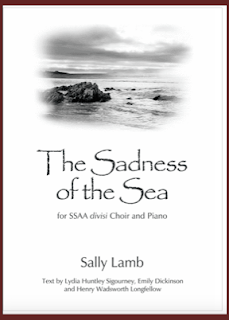 |
| Broad Cove, Inverness, Nova Scotia |
 |
| "White Point #3" by Scott Ketcham |
Sometimes the music's purpose is political as well as musical. Sally Lamb composed "Glee! The Storm is Over,"* a setting of an Emily Dickinson poem, in conjunction with the Cornell University Chorus's "No Whining, No Flowers" commissioning project. It's hardly the usual women's choir fare with its lyrics about shipwreck victims and its dissonant voices assuming the roles of clanging buoy bells on a turbulent sea. The Broad Cove Chorale--I'm singing in both it and the Unicorn Singers this season--is sandwiching this piece between a more typical, very lyrical piece in which a woman bids the wind to hasten her lover's return and an exuberant but cautionary tale about the legendary eighteenth-century female pirate, Anne Bonny. Women can choose to do other than wait, wish, and wail.
"Full Fathom Five," Vaughan Williams' setting of lines from The Tempest, casts the Unicorn Singers as bells. But the most haunting and evocative Unicorn pieces are the two in which the choir becomes the sea.
After my husband and I visited Cape Breton last summer, I blogged about the uneasiness I felt with the ocean: even though--or maybe because--for six of our seven days we saw it at its most scenic, azure-perfect, I knew there was another side to that sea story that we were not experiencing. A few weeks ago, I happened upon a description of that other side in an Alistair MacLeod Cape Breton short story:
"It is the second of November . . .. Each day dawns duller and more glowering and the waves of the grey Atlantic are sullen and almost yellow at their peaks as they pound relentlessly against the round smooth boulders that lie scattered as if by a careless giant at the base of the ever-resisting cliffs. At night, we can hear the waves rolling in and smashing, rolling in and smashing, so relentless and regular that it is possible to count rhythmically between the thunder of each: one, two, three, four; one, two, three, four.
Detail from "The Cemetery at White Point"***
"It is hard to realize that this is the same ocean that is the crystal blue of summer when only the thin oil-slicks left by the fishing boats or the startling whiteness of the riding seagulls mar its azure sameness. Now it is roiled and angry, and almost anguished; hurling up the brown dirty balls of scudding foam, the sticks of pulpwood from some lonely freighter, the caps of unknown men, buoys from mangled fishing nets and the inevitable bottles that contain no messages. And always the shreds of blackened and stringy seaweed that it has ripped and torn from its own lower regions, as if this is the season for self-mutilation--the pulling out of the secret, private, unseen hair" (98-99).
The first stanza--
"O listen to the sounding sea--reminds us that the shore feels nothing, least of all a sense of wrong-doing, and that when we are dead and gone, the sea's rhythms will persist, mourning us not at all.
That beats on the remorseless shore,
O listen, for that sound will be
When our hearts shall be no more."
But immediately we're handed a welcome emotional hairpin turn: the second stanza transforms our alienation and sense of insignificance into warming connection and intimacy:
"O listen well and listen long!The poem pivots on the power of human touch: from our position of being "folded" against the speaker, maybe against one another, we can embrace the sea's "sweeter song," feel gladdened and lifted up. And what is music if not human touch?
For sitting folded close to me,
You could not hear a sweeter song
Than the hoarse murmur of the sea."
The Unicorn Singers and the Broad Cove Chorale sing of MacLeod's "roiled," "anguished" sea, but also of that azure sea that invites; that rollicking sea that promises adventure, employment, and renown; and that wide-stretching sea that billows and pacifies. It's a moving program--sensual and meditative both--and no less timely though most present-day travelers of vast distances board airplanes more often than ships.
So join us if you can on April 8 in Hingham, Massachusetts to experience the sounding sea in all its incarnations and evocations.
And one final thing. My beloved aunt Elayne Selig died on Monday, March 12, 2018. She was an ardent swimmer, but her favorite place to swim was the ocean, no matter how cold the water was. I will be especially thinking of her when we sing Eric Whitacre's "The Seal Lullaby."
* You can listen to the piece to clicking on the image of the sheet music's cover.
** “‘In the Fall.’” Island: The Complete Stories, by Alistair MacLeod, W.W. Norton & Company, 2000, pp. 98–117.
*** http://www.scottketcham.com/image/162979802397






What a wonderful description of this music and the challenges and rewards that if offers. Bravo!
ReplyDeleteWhat a great writer you are! This is awesome!
ReplyDeleteThanks, Lenae, for reading and then posting such an appreciative comment.
ReplyDelete